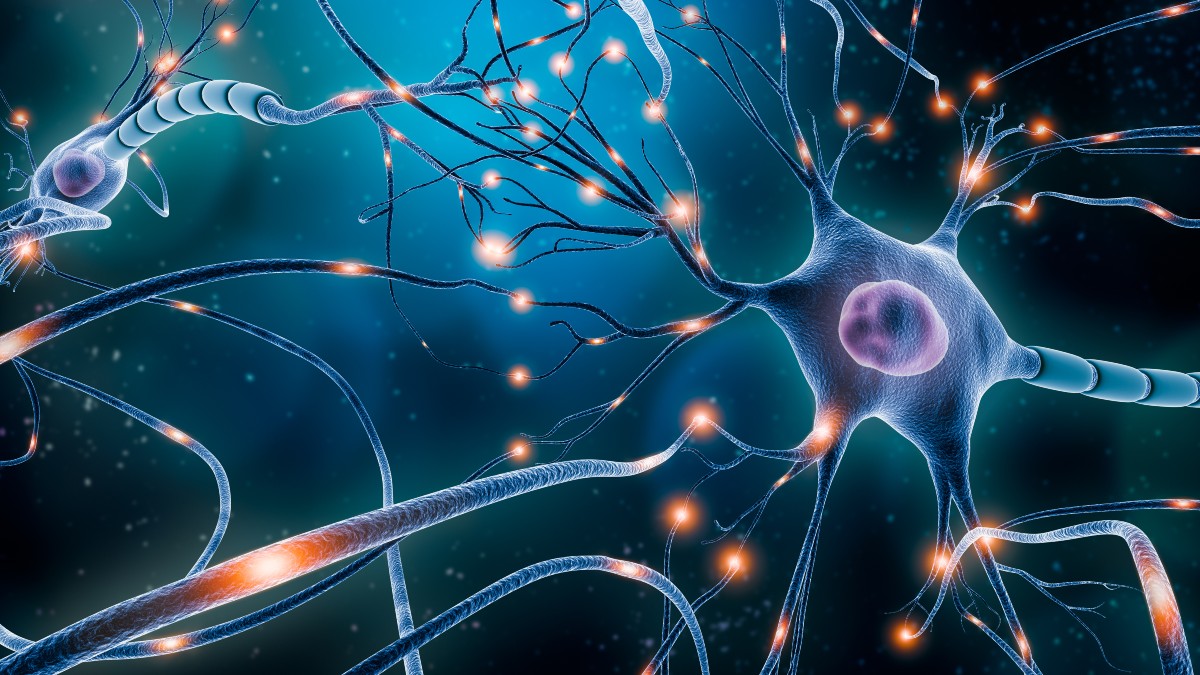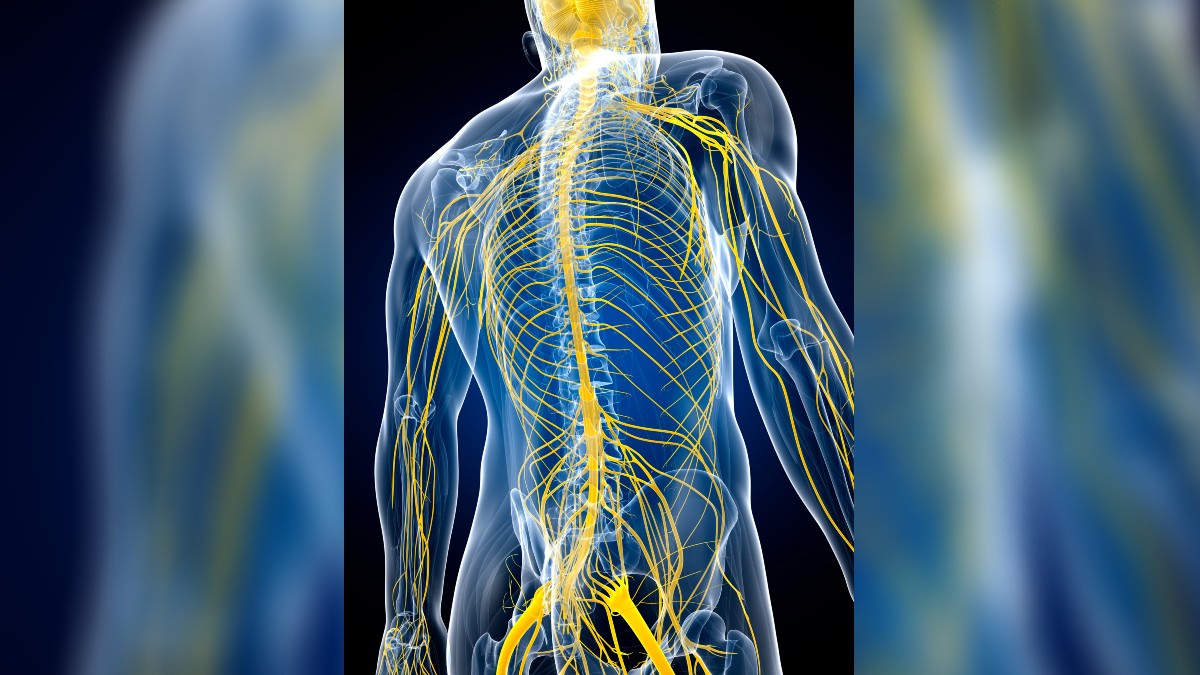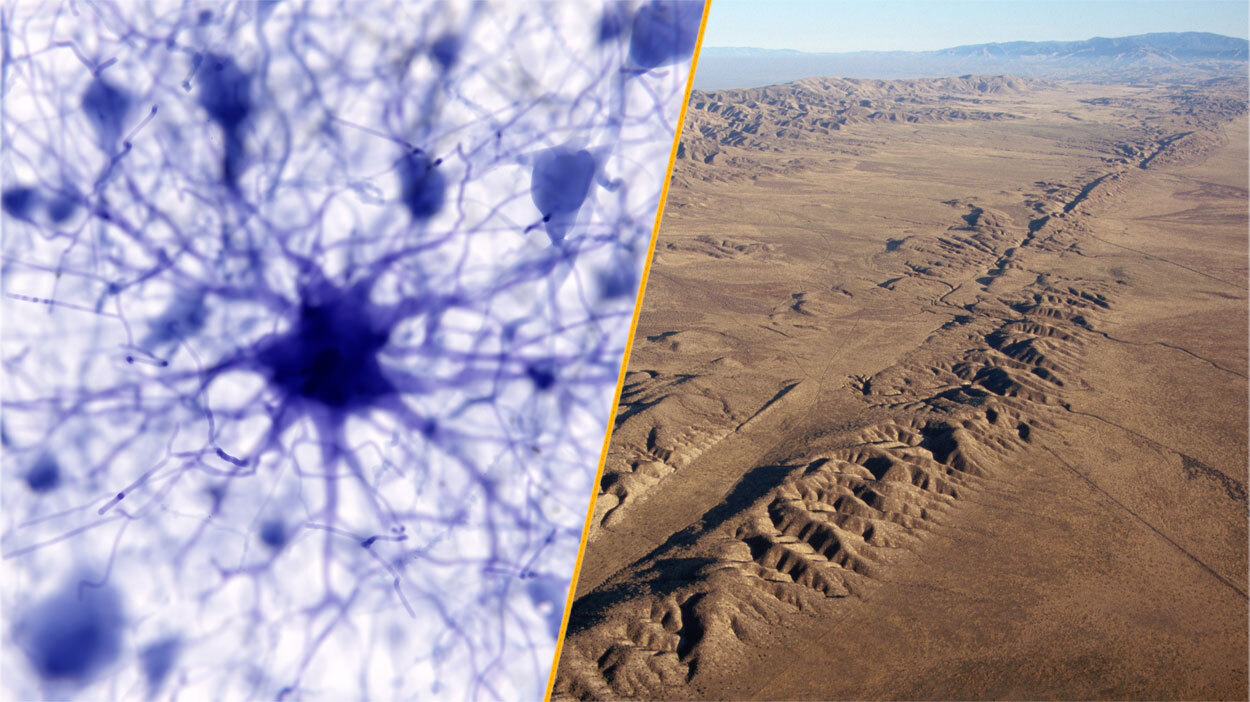The nervous system: Facts, function and diseases
Discover the human body's central nervous system and a peripheral nervous system.

The nervous system is a complex collection of nerves and specialized cells known as neurons that transmit signals between different parts of the body. It is essentially the body's electrical wiring.
Structurally, the nervous system has two components: the central nervous system and the peripheral nervous system. According to the National Institutes of Health, the central nervous system is made up of the brain, spinal cord and nerves. The peripheral nervous system consists of sensory neurons, ganglia (clusters of neurons) and nerves that connect to one another and to the central nervous system.
Functionally, the nervous system has two main subdivisions: the somatic, or voluntary, component; and the autonomic, or involuntary, component. The autonomic nervous system regulates certain body processes, such as blood pressure and the rate of breathing, that work without conscious effort, according to Merck Manuals. The somatic system consists of nerves that connect the brain and spinal cord with muscles and sensory receptors in the skin.
What is the nervous system?
Nerves are cylindrical bundles of fibers that start at the brain and central cord and branch out to every other part of the body, according to the University of Michigan Medical School.
Neurons send signals to other cells through thin fibers called axons, which cause chemicals known as neurotransmitters to be released at junctions called synapses, the NIH noted. There are over 100 trillion neural connections in the average human brain, though the number and location can vary. For example, a study published in the journal Proceedings of the National Academy of Sciences (PNAS) found that out of the 160 participants studied, the brains of highly creative people have more connections among three specific regions of the brain than less creative thinkers.
"You have these three different systems that are all located in different parts of the brain, but they are all co-activated at once," said lead study author Roger Beaty, a postdoctoral fellow studying cognitive neuroscience at Harvard University. "People who are better able to co-activate them [came] up with more-creative responses."
A synapse gives a command to the cell and the entire communication process typically takes only a fraction of a millisecond. Signals travel along an alpha motor neuron in the spinal cord 268 mph (431 km/h); the fastest transmission in the human body, according to Discover magazine.
Sensory neurons react to physical stimuli such as light, sound and touch and send feedback to the central nervous system about the body's surrounding environment, according to the American Psychological Association.
Motor neurons, located in the central nervous system or in peripheral ganglia, transmit signals to activate the muscles or glands. Glial cells, derived from the Greek word for "glue," are specialized cells that support, protect or nourish nerve cells, according to the Oregon Institute of Health and Science University.
The brain's connections and thinking ability grew over thousands of years of evolution. For example, a virus bound its genetic code to the genome of four-limbed animals, and the code can still be found in humans' brains today, according to two papers published in the January 2018 journal Cell. This code packages up genetic information and sends it from nerve cells to other nearby nerve cells, a very important process in the brain.
Divisions of the nervous system
When we think of the nervous system, our thoughts immediately go to the brain. The brain is a hive of neuronal activity, with billions of interwoven neurons firing to preserve and recall memories, coordinate thoughts and speech, and plan future actions. Along with the spinal cord, the bone-clad parts of our nervous system are naturally called the central nervous system.
The majority of our neurons are shielded behind protective fluid and bone, where they receive signals from and dictate to organs around the body. However, the signals sent from the central nervous system must have some means of reaching their target organs. And for that they need to connect to nerves that stretch from the central nervous system all the way to the extremities of the body. This second network of nerves is called the peripheral nervous system. Together, the central and peripheral form the major divisions of the nervous system, according to the National Cancer Institute.
The peripheral nervous system is responsible for many functions, and as such has numerous sub-divisions that specialise on different tasks. The sensory, or afferent, division receives signals from the periphery and carries these into the central nervous system. The motor, or efferent, division transmits signals for actions outward from the central nervous system to the peripheral organs and muscles. These motor functions come in two forms: somatic, and autonomic. Somatic functions are perhaps the easiest concept of the nervous system to grasp, as these dictate all our voluntary actions, such as choosing to pick up a cup, or jump on the bed, according to the medical library LibreTexts.

Not all somatic motor functions are voluntary, however. Some are automatic, pre-programmed responses built into our bodies that help us cope with danger, known as somatic reflexes. You’ll notice such a reflex when you accidentally touch a hot stove, step on a sharp object, or something flies toward your eye - your body reacts before you’re aware of it. Your hand pulls away, you hop onto the other foot, your eyelid slams shut. This is all the work of somatic reflexes, which can act incredibly quickly as they do not require voluntary input from the brain. Such reflexes can come in different flavours; pulling your hand away from danger is known as a flexor or withdrawal reflex, whereas stepping on a sharp object initiates a crossed-extensor reflex. This latter reflex automatically triggers multiple motor functions, as one leg retracts the other leg simultaneously expands and becomes more stable, preventing us from falling over.
The innate, hard-wired reflex responses of our peripheral nervous system help keep us safe from danger, but they are not the only automatic functions performed by the peripheral nervous system. When actions are not voluntary, or somatic, they are autonomic, which means they operate independently of conscious thought. Such processes include the heart beat, the churning of food in the digestive tract by contracting muscles, and respiration. While our brain can assume control of a few of these processes (think of holding your breath), autonomic functions will continue to operate even when we fall asleep or if we are knocked unconscious.
The processes that we cannot control, however, are by no means unchanging. Instead the organs under the control of the autonomic nervous system are regulated by a balance between the sympathetic and parasympathetic nervous systems. Depending on the stimulus, these systems increase or decrease activity of our internal organs, helping to ensure our body is always ready to respond to the challenge at hand.
Nervous system disorders
"Of all the diseases of the nervous system, the most common difficulty that people have is pain, and much of that is nerve-related," according to Dr. Shai Gozani, founder and CEO of NeuroMetrix, a medical device company. "There are 100 million people who live with chronic pain."
Parkinson’s disease
The basal ganglia are found deep within the brain, in an area responsible for controlling movement. These nerves produce a compound known as dopamine, which is important in coordinating numerous functions including executive functions and motor control. Although the cause is not yet clear, sometimes the basal ganglia can become impaired and begin to die. The result of this is Parkinson’s disease, as the loss of dopamine gradually hampers key functions such as walking, talking, and memory recall. These effects are compounded by the loss of nerves responsible for producing norepinephrine, a key compound in the sympathetic nervous system needed to regulate heart rate and blood pressure. Medicines that increase the amount of dopamine in the brain can help combat symptoms of the disease, according to the National Institute of Aging.
Bell’s Palsy
Major nerves spread outward from the central nervous system to various organs and tissues, with each powering specific functions. Cranial nerve VII is known as the facial nerve, as it controls many of the muscles on our face including blinking and smiling. When this nerve is inflamed, damaged, or otherwise disrupted Bell’s palsy can occur, which involves the facial muscles becoming weakened or paralysed, according to the National Institute of Neurological Disorders and Stroke. This typically affects only one side of the face, causing symptoms such as drooping of the mouth on one side and a loss of control of an eyelid, giving the affected side a slack appearance. The full symptoms of Bell’s palsy are often temporary, with some or total recovery of the affected areas occurring with six months. While it is not always clear what causes the cranial nerve to swell and Bell’s palsy to occur, scientists believe that a recurring viral infection of the nervous system elicits an immune response that triggers the nerve damage.
Multiple sclerosis
Neurons are the agents of signalling in our bodies, but they do not work alone. Axons, which carry signals away from the neuron’s cell body, are coated in a sheaf of myelin. Myelin sheaves are produced in the central nervous system by cells called oligodendrocytes, enabling myelin’s function of protecting and facilitating nerve conductivity, according to the National Multiple Sclerosis Society. In multiple sclerosis, an abnormal immune response within the central nervous system strips away the protective myelin and causes lots of nerve scarring (sclerosis), which gives the disease its name. Research efforts are underway to treat the disease by encouraging myelin regeneration.
Peripheral neuropathy
While several degenerative nervous system disorders primarily or exclusively impact the central nervous system, there are a collection of diseases that instead impact the peripheral nervous system. Together these diseases are referred to as peripheral neuropathies. As the impacted region is the peripheral nervous system, such neuropathies lead to loss of sensation and regulatory control of extremities. These include a loss of coordination and feeling in fingers and toes, and a lack of balance, according to the University of Michigan Health. The causes of peripheral neuropathy are yet to be fully elucidated, but scientists have determined diabetes, which causes protracted periods of high blood sugar, as one of the primary causes.
Diagnosing nervous system conditions
There are a number of tests and procedures to diagnose conditions involving the nervous system. In addition to the traditional X-ray, a specialized X-ray called a fluoroscopy examines the body in motion, such as blood flowing through arteries, according to the NIH.
Other standard neurological exams include an MRI (magnetic resonance imaging), CT scan, and an electroencephalogram (EEG), which records the brain's continuous electrical activity. Positron emission tomography (PET) is a procedure that measures cell or tissue metabolism and brain activity to detect tumors or diseased tissue or tumors, the NIH noted.
A spinal tap places a needle into the spinal canal to drain a small amount of cerebral spinal fluid that is tested for infection or other abnormalities, according to the NIH.
Neurology: Study of the nervous system
The branch of medicine that studies and treats the nervous system is called neurology, and doctors who practice in this field of medicine are called neurologists. Once they have completed medical training, neurologists complete additional training for their specialty and are certified by the American Board of Psychiatry and Neurology (ABPN).
There are also physiatrists, who are physicians who work to rehabilitate patients who have experienced disease or injury to their nervous systems that impact their ability to function, according to the ABPN.
Neurosurgeons perform surgeries involving the nervous system and are certified by the American Association of Neurological Surgeons.
Additional resources
For more information about your body's nervous system, check out “The Human Nervous System” by Juergen K. Mai and “The Big Book Of The Human Body” by Katherine Marsh
Bibliography
- James Ashley, et al, “Retrovirus-like Gag Protein Arc1 Binds RNA and Traffics across Synaptic Boutons”, Cell, Volume 172, January 2018.
- Roger E. Beaty, “Robust prediction of individual creative ability from brain functional connectivity”, PNAS, Volume 115, January 2018.
- Valerie Ross, “Numbers: The Nervous System, From 268-MPH Signals to Trillions of Synapses”, Discover Magazine, mAY 2011.
- University of Michigan Health, “Peripheral Neuropathy”, August 2020.
- National Institute of Neurological Disorders and Stroke, “ Bell's Palsy Fact Sheet”, November 2021.
- National Institute of Aging, “Parkinson’s Disease”, May 2017.
- National Library of medicine, “Neurologic Diseases”, March 2022.
- National Multiple Sclerosis Society, “What is Myelin”, accessed March 2022.
Sign up for the Live Science daily newsletter now
Get the world’s most fascinating discoveries delivered straight to your inbox.
James Horton holds a PhD in evolutionary biology from the University of Bath in the U.K. and has been writing about science since 2016. His work has been featured in The Conversation UK and BBC Future, and he’s been an interviewee on Spark podcast on Canadian Broadcasting Corporation. James currently works as a research scientist where he studies the causes of mutations and how these processes shape the evolution of bacterial genomes.
- Alina BradfordLive Science Contributor
- Kim Ann ZimmermannLive Science Contributor

